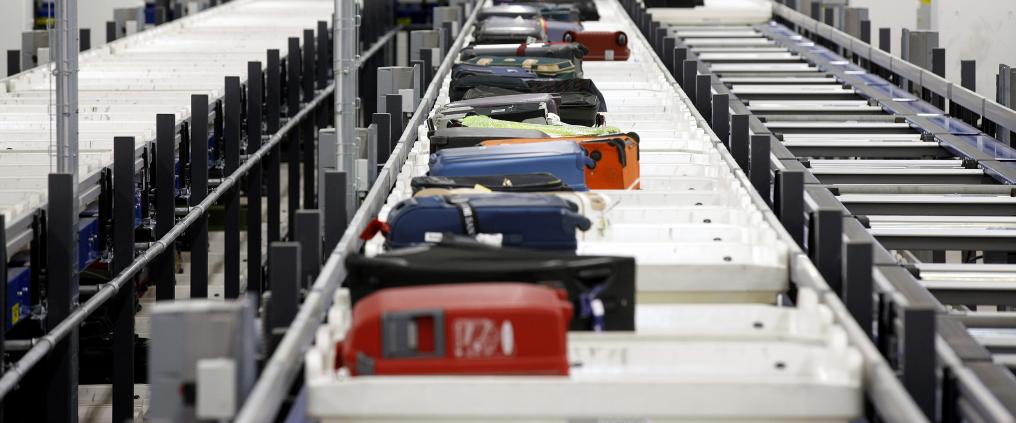Baggage handling at Helsinki Airport is a critically important operation that requires close collaboration between airlines, Finavia’s baggage handling and ground handling companies. Everyone must work together seamlessly, under a tight schedule: At best, luggage has to make it from one flight onto another – possibly via security check – in just 35 minutes.
With the help of automated processes, thousands of bags can be transported from check-in to the cargo hold per hour. Still, many critical phases are still carried out manually.
At check-in, luggage is tagged
Baggage handling begins at check-in. More and more often, bags are dropped off at a self-service counter, where the passenger prints out the baggage tags. The barcode in the tag is crucial for baggage handling.
Thanks to the barcode, the bag will find its way to the right aircraft, and the control system can track its journey in real time.
After the tag has been fastened onto the luggage, the luggage is taken to the correct airline’s bag drop, where the passenger scans the barcodes in his or her boarding pass and the baggage claim tag. The machine weighs and measures the bag.
“Overweight or special baggage, such as sports equipment and pets travelling in the cargo hold, are handled separately”, notes Marko Lappalainen, Head of Equipment Maintenance at Finavia.
Normally, after the bag has been checked into the system, it is transported by a conveyor belt from the scales into Finavia’s luggage factory, where it embarks on a rollercoaster-like journey.
The barcode tells where the luggage is headed
A piece of luggage travels through the baggage handling system in what is called a tote, a dedicated conveyor cart. The tote can reach a speed of up to seven metres per second in a long tunnel. The system steers the tote and luggage in the right destination based on information included in the barcode in the baggage claim tag.
In addition to barcode readers, the baggage sorting and tracking systems utilise RFID readers and cameras. If a machine cannot read the barcode due to, for example, a crumpled tag, the luggage must be recoded manually by Finavia’s baggage handling staff. This may cause a delay in the bag’s journey.
All baggage is inspected and screened according to EU norms. After security screening, baggage that has been checked in and dropped off early proceeds to the early baggage storage, an automated “luggage hotel”, from which the bag is released according to the flight’s departure time.
From sorting to ramp to cargo hold
Sortation is the last leg of a bag’s journey through the luggage factory. Two sorter machines sort the baggage into flight-specific ramps. There are currently a hundred ramps in the baggage handling system. After sliding down the ramp, a piece of luggage is in the care of a ground handling company whose luggage handlers then load the bags into carts or containers, depending on what type of plane awaits them.
“Luggage is still hoisted from the ramp into the cart or container manually. For health and safety reasons, there are limits to how much a piece of baggage can weigh. Most airlines allow a maximum weight of 23 kg for checked baggage”, says Juha Sinivuori, Head of Baggage and Transport at Swissport Finland Oy, which offers ground handling services.
Consequently, a good physical condition is required from baggage handlers.
Finally, the carts or containers are towed to the aircraft with a tow tractor. From a cart the bags are “bulk loaded” in the cargo hold one by one, while containers are loaded into the cargo hold as such.
Baggage handling can be a question of minutes
According to Lappalainen, baggage handling at Helsinki Airport has been affected by the growing number of transfer passengers: the pace has increased significantly.
Thanks to automation and digital tools, checked baggage virtually always makes it to the plane right on time, even during afternoon traffic. However, despite automation, people still play an important part in baggage handling.
“An automatic system is a big help in transporting baggage to the right place, but in case of any unclarity, it is humans who solve the problems and make the decisions”, Lappalainen says.
“Moreover, the whole system is operated and monitored by process and maintenance operators around the clock, every single day.”, he concludes.
Heini Noronen-Juhola, Vice President, Aviation & Safety at Finavia, and Marika Nieminen, Head of Customer and Baggage Processes at Finnair, were also interviewed for this article.
Watch a video about Finavia’s corporate responsibility – the Sum of Good things.




